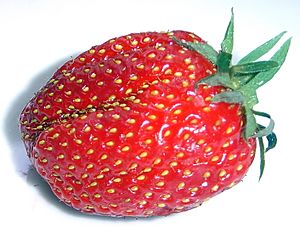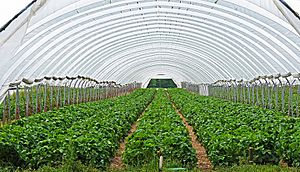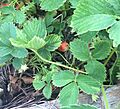Strawberry facts for kids
Quick facts for kids Strawberry Plant |
|
|---|---|
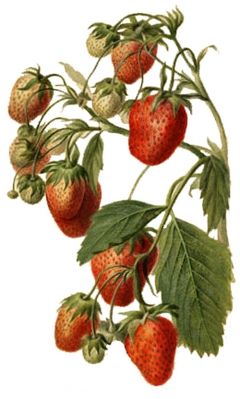 |
|
| Scientific classification | |
| Kingdom: | |
| Division: | |
| Class: | |
| Order: | |
| Family: | |
| Subfamily: | |
| Tribe: |
Potentilleae
|
| Subtribe: |
Fragariinae
|
| Genus: |
Fragaria
|
A strawberry is a yummy fruit that grows on a plant. When a strawberry is ready to eat, it turns a bright red color. It's special because its tiny seeds are on the outside! Lots of people enjoy strawberries on ice cream or dipped in sugar. Strawberries are super healthy, packed with vitamin C and manganese.
Many strawberries grow on big farms. Farmers often keep bees on their farms. These bees help pollinate the strawberry plants, which means they help the plants make fruit. Strawberries are technically "aggregate fruits." This means they are made up of many tiny fruits joined together. The stems that grow above ground are called runners, which are a type of stolon. The true fruits are actually the tiny seeds (called achenes) on the outside.
Contents
The Amazing History of Strawberries
Strawberries have a long and interesting past! People have enjoyed them for hundreds of years.
Where Did Garden Strawberries Come From?
The first garden strawberry we know today was grown in Brittany, France. This happened in the late 1700s. Before that, people mostly ate wild strawberries. Or they grew special types of wild strawberries in their gardens.
Ancient Romans wrote about strawberries. They used them for medicine. In the 1300s, French people started bringing wild strawberries from forests into their gardens. King Charles V of France had 1,200 strawberry plants in his royal garden!
In the 1400s, monks in Europe drew wild strawberries in their special books. You can find strawberries in old Italian, Flemish, German, and English art. People even used the whole strawberry plant to help with sadness.
How Strawberries Became Popular
By the 1500s, growing strawberries became more common. People used them for their supposed health benefits. Scientists also started naming the different kinds of strawberries. In England, more and more people wanted to grow strawberries by the mid-1500s.
The yummy mix of strawberries and cream was first made by Thomas Wolsey. He was a powerful person in the court of King Henry VIII. In 1578, people started writing down how to grow and pick strawberries. By the end of the 1500s, three types of European strawberries were known: F. vesca, F. moschata, and F. viridis. Garden strawberries were moved from forests. Then, new plants were grown from their runners. This is a way of growing plants without seeds.
The Birth of Modern Strawberries
Two types of F. vesca were found: F. sylvestris alba and F. sylvestris semperflorens. A big moment in strawberry history happened in the 1600s. A type called F. virginiana came to Europe from North America. This is one of the two main types that created the modern strawberry we eat today.
This new strawberry slowly spread across Europe. People didn't fully appreciate it until the late 1700s. In 1712, a French trip to Chile brought back a strawberry plant with only female flowers. This plant led to the common strawberry we have now.
Native people in Chile, the Mapuche and Huilliche, grew this female strawberry type until the Spanish arrived in 1551. In 1765, a European explorer wrote about growing F. chiloensis, the Chilean strawberry. When these plants first came to Europe, they grew well but didn't make fruit.
French gardeners in Brest and Cherbourg noticed something in the mid-1700s. If they planted F. moschata and F. virginiana plants near F. chiloensis, the Chilean strawberries would grow lots of big fruits! Soon after, Antoine Nicolas Duchesne started studying how strawberries reproduce. He made important discoveries about plant breeding. He published his findings in 1766.
Duchesne found that the female F. chiloensis plants needed male F. moschata or F. virginiana plants to make fruit. This is how Europeans learned that some plants have only male or only female flowers.
Duchesne figured out that F. ananassa was a mix of F. chiloensis and F. virginiana. F. ananassa makes large fruits. It got its name because it smells, tastes, and looks a bit like a pineapple. In England, many types of F. ananassa were created. These became the basis for most modern strawberries. More breeding was done in Europe and America. This helped make strawberries stronger, more resistant to disease, bigger, and tastier.
How Strawberries Are Grown
Strawberry plants come in many different sizes, colors, flavors, and shapes. They also vary in how much fruit they produce. On average, a strawberry has about 200 seeds on its outside! Some plants have different leaves. Some flowers look like they have both male and female parts, but they only work as one or the other.
Growing Strawberries for Sale
For big farms, new strawberry plants are grown from runners. These are usually sold as bare root plants or plugs. There are two main ways to grow strawberries:
- Annual Plasticulture: This method involves planting new strawberries every year.
- Perennial System: This method uses the same plants for several years.
Greenhouses also grow a small amount of strawberries when they are not in season.
Most modern farms use the plasticulture system. Each year, farmers make raised beds. They might treat the soil to prevent weeds. Then, they cover the beds with plastic. This plastic stops weeds from growing and helps protect the soil. Young plants are put into holes in the plastic. Water tubes are placed underneath. Farmers remove any new runners from the plants. This helps the plants put all their energy into growing fruit. After the harvest, the plastic is removed, and the old plants are plowed into the ground.
Strawberry plants usually produce less fruit and lower quality fruit after a year or two. So, replacing them every year helps farms get more fruit from a smaller area. However, this system needs a longer growing season. It also costs more because of the plastic and buying new plants. So, it's not always used everywhere.
The other main way to grow strawberries is to use the same plants year after year. These plants grow in rows or on mounds. This method is common in colder places. It costs less to start and needs less care. But it usually produces less fruit than plasticulture.
Another way to grow strawberries uses something called a "compost sock." Strawberries grown this way have more healthy things in them. This includes vitamins and sugars, compared to other methods.
Different Types of Strawberry Plants
Strawberries are often grouped by when they produce flowers.
- "June-bearing" strawberries make their fruit in early summer.
- "Ever-bearing" strawberries can produce fruit several times throughout the season. One plant might produce fruit every three days!
Scientists found in 2001 that there are actually three main types of strawberries based on how they flower:
- Short-day
- Long-day
- Day-neutral
These names refer to how much daylight the plant needs to start making flowers. Day-neutral types make flowers no matter how long the day is.
You can also grow strawberries from seeds. But this is mostly a hobby. It's not widely done on big farms. A few types grown from seed have been made for home gardeners. Scientists are still researching how to grow strawberries from seeds for farms. You can buy seeds from stores or collect them from the fruit itself.
Strawberries can even be grown indoors in special pots. With special LED lights (blue and red), you can grow them inside during winter. In some warm places like Florida, winter is actually the best time to harvest strawberries!
The Kashubian strawberry is a special type from Poland. It's the first Polish fruit to have special protection under European Union law. These strawberries are grown in specific areas of Poland. Only certain types of strawberries can be sold as kaszëbskô malena.
Caring for and Harvesting Strawberries
Most strawberry plants on farms are given special plant food. This happens before planting, and often before and after picking the fruit.
To keep strawberries fresh and tasty, they are picked almost every day. The berries are picked with their green caps still on and at least half an inch of stem. Strawberries need to ripen fully on the plant. They won't ripen more after they are picked. Any rotten or overly ripe berries are removed. This helps prevent bugs and diseases. Strawberries are not washed until right before you eat them.
Farmers use soil tests to decide how much plant food to use. Nitrogen fertilizer is needed at the start of each planting year. Most fields already have enough phosphorus and potash for good harvests. To add more good stuff to the soil, farmers might plant a cover crop like wheat or rye in winter. Strawberries like soil with a pH between 5.5 and 6.5.
Picking and cleaning strawberries hasn't changed much. Delicate strawberries are still picked by hand. Sorting and packing often happen right in the field. On big farms, strawberries are cleaned with water and shaking conveyor belts.
Strawberry Pests
About 200 different kinds of pests can attack strawberry plants. These include slugs, moths, fruit flies, weevils, thrips, beetles, and aphids. The caterpillars of some moths also eat strawberry plants. For example, the Ghost moth can be a pest for strawberries.
The strawberry aphid is a tiny bug found in the United States, Argentina, and Chile. It can carry a virus called the strawberry mild yellow-edge virus.
Growing lots of strawberries on big farms often needs a lot of pesticides. Because of this, strawberries are sometimes on lists of produce with the most pesticide residue.
Growing Strawberries at Home
Strawberries are fun and easy to grow at home! You can grow them for eating or just for show, almost anywhere in the world. The best time to plant them is in late summer or spring. Plant them where they get lots of sun or some shade. They like slightly sandy soil. Adding plant food and fertilizer helps them grow strong. You can also plant them in pots or special planters using compost. Placing mats under each plant helps keep the fruit off the ground. This also helps stop weeds.
Strawberries are tough plants and can survive many conditions. But when they are growing fruit, they need water, especially in pots. You also need to protect them from slugs and snails, which like to eat ripe fruit. The fruit ripens in midsummer (wild types might ripen earlier). Pick them when they are a bright, even red color. If you plant different types, you can have strawberries for a longer time. Many different types have been created for eating and for showing.
You can grow new strawberry plants from their runners. You can pin these runners down to help them grow roots. Or you can cut them off and plant them in a new spot. Older plants should be replaced every three years. Replace them sooner if you see signs of disease.
When growing new strawberries, try not to use the same soil or pots that had strawberries before. After growing strawberries, it's a good idea to grow a different plant next. This is because diseases that affect strawberries might not affect other plants.
How We Use Strawberries in Food
Besides eating them fresh, strawberries can be frozen. They can also be made into jam or preserves. You can even dry them and use them in foods like cereal bars. Strawberries and strawberry flavors are popular in dairy products. Think of strawberry milk, strawberry ice cream, strawberry milkshakes/smoothies, and strawberry yogurts.
In the United Kingdom, "strawberries and cream" is a very popular dessert. People eat it a lot at the Wimbledon tennis tournament. Strawberries and cream is also a common snack in Mexico. You can usually find it at ice cream shops. In Sweden, strawberries are a traditional dessert for St John's Day, also called Midsummer's Eve.
Depending on the area, you might find strawberry pie, strawberry rhubarb pie, or strawberry shortcake. In Greece, strawberries might be sprinkled with sugar. Then they are dipped in Metaxa, a type of brandy, and served as a dessert. In Italy, strawberries are used in many desserts. They are also a common flavor for gelato (gelato alla fragola).
Strawberry Nutrition Facts
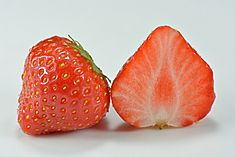 |
|
| Nutritional value per 100 g (3.5 oz) | |
|---|---|
| Energy | 136 kJ (33 kcal) |
|
7.68 g
|
|
| Sugars | 4.89 g |
| Dietary fiber | 2 g |
|
0.3 g
|
|
|
Protein
|
0.67 g
|
| Vitamins | Quantity
%DV†
|
| Thiamine (B1) |
2%
0.024 mg |
| Riboflavin (B2) |
2%
0.022 mg |
| Niacin (B3) |
2%
0.386 mg |
| Pantothenic acid (B5) |
3%
0.125 mg |
| Vitamin B6 |
4%
0.047 mg |
| Folate (B9) |
6%
24 μg |
| Choline |
1%
5.7 mg |
| Vitamin C |
71%
58.8 mg |
| Vitamin E |
2%
0.29 mg |
| Vitamin K |
2%
2.2 μg |
| Minerals | Quantity
%DV†
|
| Calcium |
2%
16 mg |
| Iron |
3%
0.41 mg |
| Magnesium |
4%
13 mg |
| Manganese |
18%
0.386 mg |
| Phosphorus |
3%
24 mg |
| Potassium |
5%
154 mg |
| Sodium |
0%
1 mg |
| Zinc |
1%
0.14 mg |
| Other constituents | Quantity |
| Water | 90.95 g |
| †Percentages estimated using US recommendations for adults. | |
Raw strawberries are mostly water (91%). They have about 8% carbohydrates and 1% protein. They have almost no fat. A 100-gram serving of strawberries has 33 kilocalories. It's a great source of vitamin C (71% of what you need daily!). It's also a good source of manganese (18% of what you need daily). Strawberries also give you small amounts of other vitamins and minerals. The tiny seeds on the outside have a small amount of healthy fats.
Images for kids
See also
 In Spanish: Fresa para niños
In Spanish: Fresa para niños



